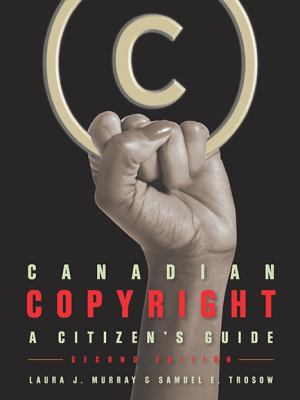Canadian copyright: A citizen's guide
About the book
Author: Murray, Laura J. with Samuel E. Trosow
Title: Canadian copyright: A citizen’s guide. (2nd edition)
Publication: Toronto : Between the Lines, 2013. ISBN 9781771130134.
About the book
I initially read the first edition of this book in 2007. I was struck by how clearly the authors explained the history of copyright in Canada. They clearly demonstrate how that history informs Canadian law, and how the law informs the practice of individuals and groups across our society.
Ironically, it is often much easier for Canadians to be informed about “fair use” (an American copyright principle, as opposed to “fair dealing”, used in Canada) and the DMCA than it is to know about the laws that govern our daily practice here in Canada. This book goes a long way towards addressing this lack of understandable information in Canada.
This second edition has been revised and expanded to include the many changes brought about by [Bill C-11, the Copyright Modernization Act]{http://copyright.ubc.ca/copyright-legislation/bill-c-11-the-copyright-modernization-act/), which amended Canadian copyright legislation in 2012.
This book takes the very complicated legal framework that is the Canadian Copyright Act, explains it and makes it understandable to the layperson, providing concrete examples from case law to illustrate how the law has been interpreted. Surprisingly, it is quite readable and, at times, fascinating.
The book is divided into four main parts:
- Part I — Ideas, starts out with a description of why copyright came about, and examines the origin of the Canadian law by describing the evolution of the British, French and American concepts and how they influenced Canadian lawmakers.
- Part II — Law, looks at the scope of copyright (what is covered, and what is not) and contrasts owner’s rights with users’ rights. It also looks at copyright collectives representing authors and owners (such as Access Copyright) and goes into how copyright ownership of a work is determined and enforced.
- Part III — Practice, discusses particular nuances of copyright application, including music; digital media; film, video and photography; visual arts; craft and design; journalism; education; and libraries, archives and museums.
- Part IV — Contexts, looks at alternatives to copyright such as Indigenous Cultural Property concepts, the academic citation economy, the Open Source Knowledge movement and phenomena such as Creative Commons and GPL licenses. It also looks towards the future, predicting what may happen in the post-Bill C-11 world.
For the first time, our common daily practice brings us into almost daily contact with copyright law—knowing both our rights and what we can and cannot do (and the reason why) matters to us more with each post.
This book explains complex copyright concepts in a very accessible manner. It should be required reading for librarians, educators and any Canadian who is interested in creator’s or user’s rights in a modern Internet-enabled world.
Recommended?
I highly recommend this very readable book.
